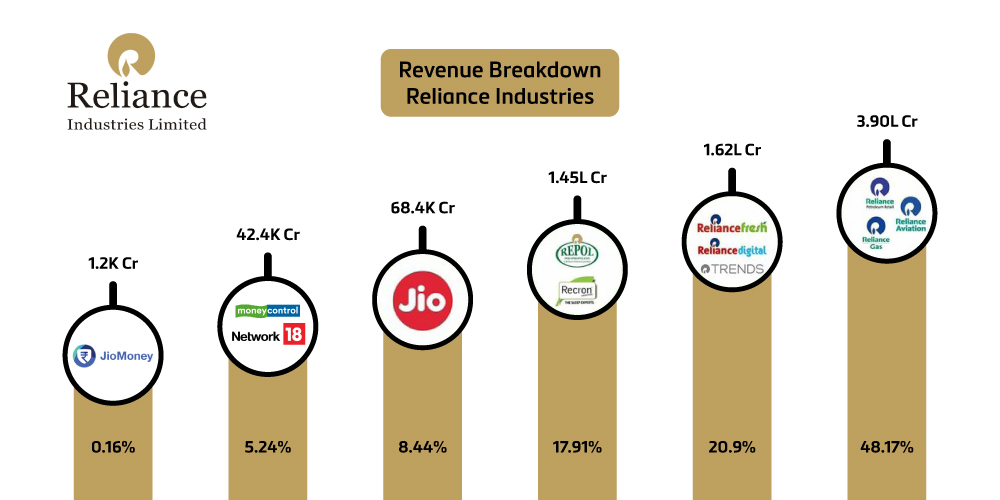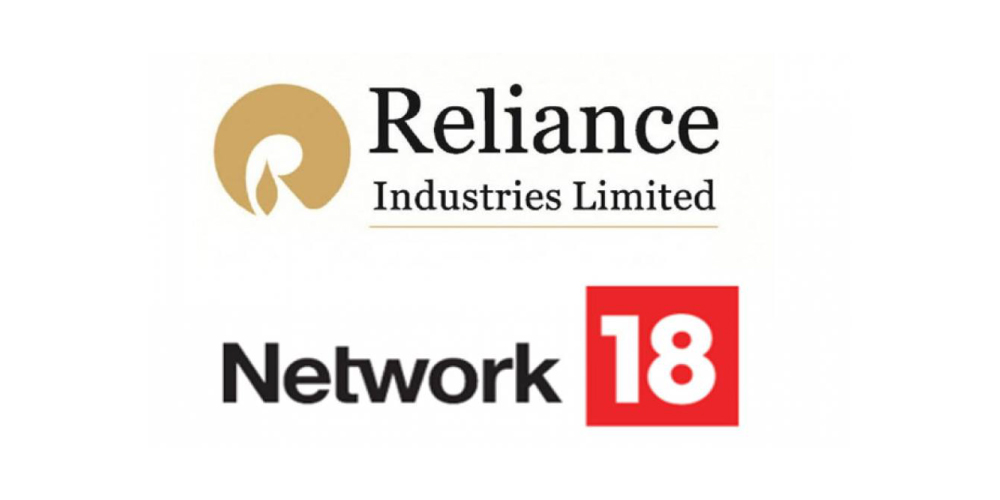Reliance Industries Limited is an Indian multinational conglomerate company, which headquarters placed in Mumbai. It has diverse businesses including energy, petrochemicals, natural gas, retail, telecommunications, mass media, and textiles. Reliance is one of the most profitable companies in India, the largest publicly traded company in India by market Capitalisation, and the largest company in India as measured by revenue. It is also one of the top largest employers in India with 10,00,000 employees directly and indirectly in the world.
The company is ranked 104th on the Fortune Global 500 list of the world's biggest corporations as of 2022. Reliance continues to be India's largest exporter, accounting for 10% of India's total merchandise exports and access to markets in over 100 countries. Reliance is responsible for almost 10% of the government of India's total revenues from customs and excise duty. It is also the highest-income taxpayer in the private sector in India. The company has free cash flows. Reliance Industries became the first Indian company to cross 100 billion dollars in revenues.
The company was co-founded by Dhirubhai Ambani and Champaklal Damani in the 1960s as Reliance Commercial Corporation. In 1965, the partnership ended and Dhirubhai continued the polyester business of the firm. In 1966, Reliance Textiles Engineer Pvt. Ltd. was incorporated in Maharashtra.
Reliance Industry Shareholding
The number of shares of RIL is approx. 644.51 crore. The promoter group, the Ambani family, holds 50.00% of the total shares whereas the remaining 50.00% of shares are held by public shareholders, including FII and corporate bodies. Life Insurance Corporation of Indi is the largest non-promoter investor in the company, with a 7.98% shareholding.
In January 2012, the company announced a buyback program to buy a maximum of 12 crores (120 million) shares for ₹10,400 crores (US$1.5 billion). By the end of January 2013, the company had bought back 4.62 crores (46.2 million) shares for ₹3,366 crores (US$420 million).
Business Model Of Reliance Industries

1. Retail
It marks its importance in being a world-class shopping platform, which provides quality services to customers. This also operates supermarkets, hypermarkets, wholesale cash, carry stores, specialty stores, and online stores and provides access to all kinds of products to all customers. In March 2013, it had 1466 stores in India. It is the largest retailer in India. Many brands like Reliance Fresh, Reliance Footprint, Reliance Time Out, Reliance Digital, Reliance Wellness, Reliance Trends, Reliance Autozone, Reliance Super, Reliance Mart, Reliance iStore, Reliance Home Kitchens, Reliance Market, Reliance Jewel come under the Reliance Retail brand. Its annual revenue for the financial year 2012-13 was Rs. 108 Billion with an EBITDA of Rs. 780 Million. Its market value is more than $60 Billion Dollar.
2. Reliance Petroleum Ltd.
The company brought up the opportunity of working with the global refining sector. In 1991, it brought a subsidiary which is known as Reliance Refineries Private Ltd, which was later known as Reliance Petroleum Limited.
In 1993, the company further continued to lead financing channels in India and became the first company to raise capital in the foreign market in Luxembourg. It finally got its opportunity to enter the Oil and Gas industry in 1997, when the Indian oil industry reached a state of collapse.
3. Reliance Logistics
Reliance Logistics is a single-window company selling transportation, distribution, warehousing, logistics, and supply chain-related products. Reliance Logistics is an asset-based company with its own fleet and infrastructure. It provides logistics services to Reliance group companies and outsiders.
4. Network18

Network 18, a mass media company. It has an interest in television, digital platforms, publications, mobile apps, and films. It also operates two joint ventures, namely Viacom 18 and History TV18 with Viacom and A+E Networks respectively. It also has acquired a partial part o the ETV network and has since renamed its channels under the Colors TV brand.
5. Jio Platform
Jio Platforms Limited, essentially a technology company, is a majority-owned subsidiary of RIL. It has a valuation of more than $100 billion on expert view as of August 2022. This new subsidiary holds all the digital business assets including Reliance Jio Infocomm Ltd, which is turn holds the Jio connectivity business - Mobile, Broadband, and enterprise and also the other digital assets like Jio Apps, Tech backbone, and investment in other tech entities like Hapti, Hathway and Den Networks among others. In April 2020 RIL announced a strategic investment of Rs. 43,574 crores by Facebook into Jio Platforms. This investment translated into a 9.99% equity stake, on a fully diluted basis.
Reliance Industries Revenue Model

The Financial Services of Reliance contributes 0.16% of the total revenue share. The Digital Services marks its contribution of around 8.44% with its Jio services and 17.91% of its contribution in Petrochemicals services. Its Organised Retail business has two brands Reliance Fresh and Reliance Digital and contributes around 20.09% of the revenue model. The refining and marketing business model contributes around 48.17% of the revenue share.
